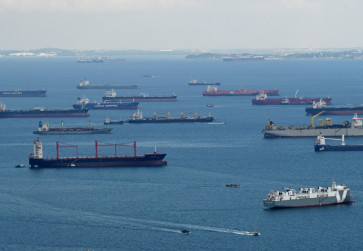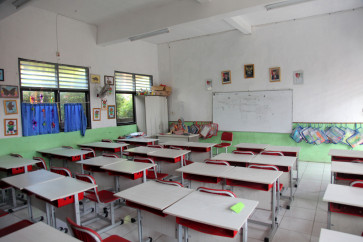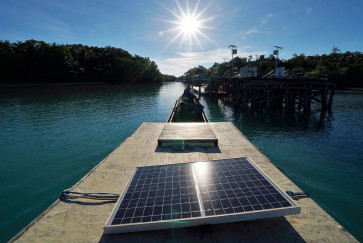Popular Reads
Top Results
Can't find what you're looking for?
View all search resultsPopular Reads
Top Results
Can't find what you're looking for?
View all search resultsFrom galleons to globalization: Uniting Asia, Latin America
We often think of globalization as a modern phenomenon, but nearly five centuries ago, Asia and Latin America were vibrant trading partners
Change text size
Gift Premium Articles
to Anyone
W
e often think of globalization as a modern phenomenon, but nearly five centuries ago, Asia and Latin America were vibrant trading partners.
Spanish trading galleons sailed regularly across the Pacific Ocean between Manila and Acapulco, trading spices and silk from India and China for silver from vast mines in Mexico and Peru. The ties between what was known as the East Indies and the West Indies were deep, and profitable.
Today, we are witnessing an intensification of those historic East-West ties.
Since 2000, trade between Asia and Latin America and the Caribbean (LAC) has been growing at an annual average rate of 20 percent, reaching around US$430 billion in 2011. China is now Latin America’s second-most important trading partner, fast gaining on traditional US dominance.
Foreign direct investment flows between the two regions has also surged during the last decade driven largely by firms from China, Japan and Korea on the Asian side and Brazil and Mexico on the Latin American side.
In just eight years, 18 free trade agreements have been implemented between economies in the two regions, with four more signed and another eight under negotiation.
There are two reasons for this interconnectivity. First, world growth particularly in developed economies has remained sluggish while Asian and Latin American economies are experiencing much higher growth. Second, specialization has occurred according to comparative advantage with Asia exporting manufactured products in return for commodities such as mineral, energy and agricultural resources from Latin America.
This dynamic trading and investment relationship has helped the Latin American region post average growth of around 5 percent over the past decade and Asia nearly 7 percent growth. Indeed, rapid trade and investment led growth in Asia and Latin America, as well as between them, has helped reduce acute poverty and will propel large sections of populations to middle class status in the next decade or so.
Indeed, Asia and Latin America today are two vital engines of growth on which the rest of the world’s economies increasingly depend.
A ground-breaking study being published this week by the Asian Development Bank (ADB) Institute and the Inter-American Development Bank (IDB) provides a revealing glimpse into this dynamic new partnership.
The report, “Shaping the Future of the Asia-Latin America and the Caribbean Relationship,” outlines not only the vast potential for further deepening of economic ties, but perhaps more importantly, it describes the many opportunities to share development knowledge and experiences that could help both regions manage their growth in a way that maximizes social equity and minimizes environmental impact.
Latin America has much to learn from Asia’s world-class education systems, high level of science and technology sophistication, outward-oriented policies that led to the formation of regional supply chains, public-private sector partnerships and regional financial cooperation initiatives, such as the Chiang Mai Initiative
Asia could benefit from studying Latin America’s experiences in poverty reduction and social safety net policies, agricultural productivity practices and the promotion of sustainable cities.
As our regions pursue greater trade and investment, there will be barriers to overcome. Asia is not only China, India and Japan, just as Latin America is not only Brazil, Mexico and Argentina. Trade and investment can be broadened in scope and geography.
Better connectivity is needed. Combining physical cross-border infrastructure with overall logistics and trade facilitation — the so-called “soft infrastructure” — will support market-led cross-regional integration.
National regulations and standards need to be conducive to greater private sector investment, particularly in higher value-added products, services and technologies. The two regions need to move the current “commodity-for-manufacturing” pattern of trade and investment to the next level.
Finally, a combination of outward-oriented development strategies, business-friendly climates, and continuous investment in human capital will help sustain the progress both Asia and Latin America have achieved thus far.
To ensure cross-regional knowledge-sharing has the greatest impact, the ADB and the IDB have established a South-South cooperation agreement to help their members deal with complex issues such as regional integration, infrastructure, renewable energy, climate change, institutional development and social policy.
As presidents of the leading development financing institutions in the two regions, we are this
year attending each other’s annual meetings for the first time, to drive home the importance of this deepening relationship, which goes far beyond simply boosting trade and investment.
As partners, we have a shared stake in sustainable growth that will protect our natural resources and environment, maximize each region’s comparative advantage, and promote equitable social
development.
Some of us call this the “Decade of Latin America and the Caribbean.” Others refer to the times we are living as the “Asian Century.” We believe that if we work together, both regions will share in an era of progress and prosperity that the captains of those long-ago galleons could only begin to imagine.
Haruhiko Kuroda is the President of the Asian Development Bank. Luis Alberto Moreno, President of the Inter-American Development Bank, is attending this week’s ADB annual meeting in Manila










